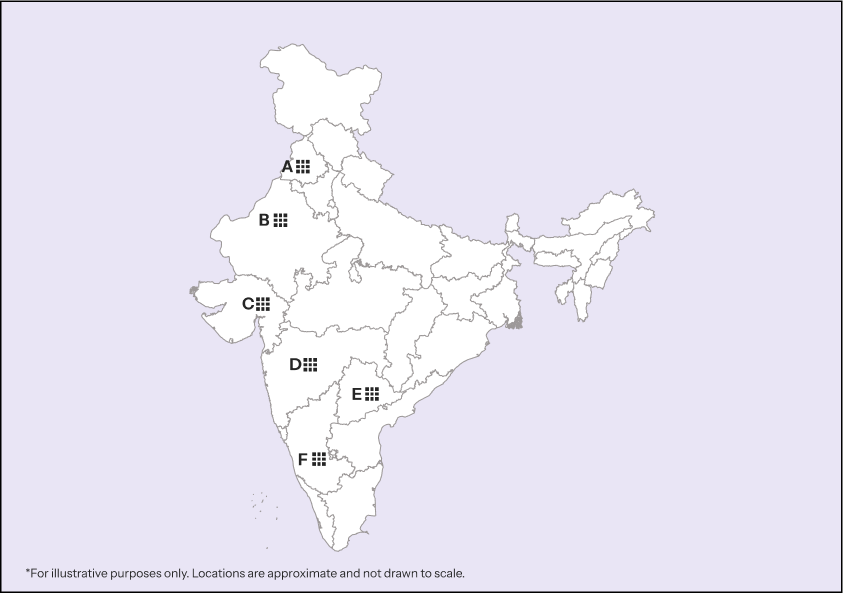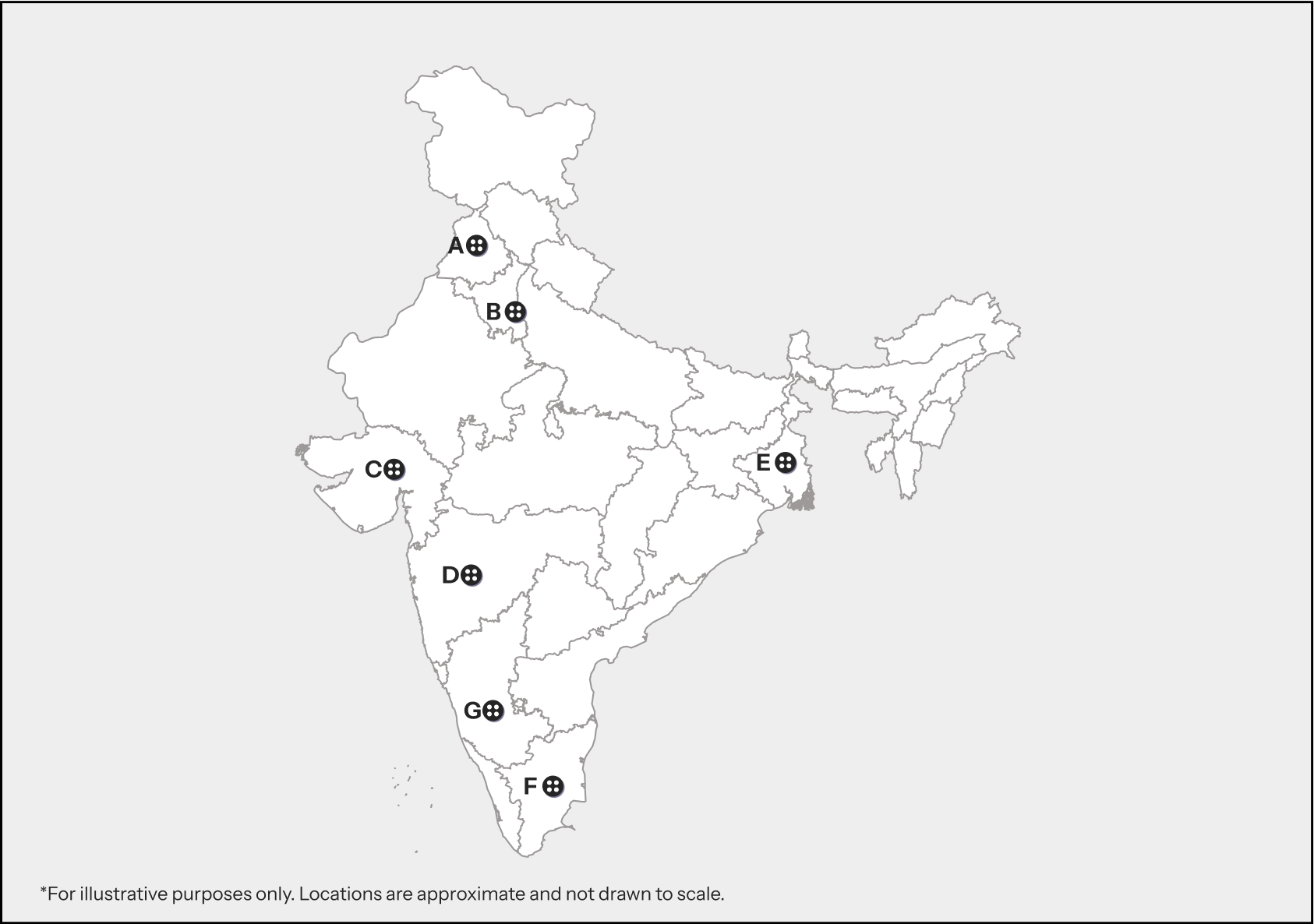*All data is in tonnes per annum
TEXTILE WASTE*
7,793,348
Post consumer textile waste
3,943,678
COTTON & COTTON RICH
61%
Polyester
9%
cotton - poly elastene
19%
Wool
0%
man-made fibre
5%
others
5%
acrylic
0%
pre consumer textile waste
Post Industrial textile waste
3,265,670
COTTON & COTTON RICH
61%
Polyester
4%
cotton - poly elastene
6%
Wool
2%
man-made fibre
3%
others
24%
acrylic
0%
Imported textile waste
584,000
COTTON & COTTON RICH
60%
Polyester
5%
cotton - poly elastene
0%
Wool
5%
man-made fibre
0%
others
5%
acrylic
25%
*This data is from Sorting for Circularity India
KEY POINTS ON Textiles & Apparels LANDSCAPE
$108B
India's Apparel Market
$14.5B
India's Apparel Export (2023)
India is the second-largest producer of textiles and garments and the fifth-largest exporter in the world. About 80% of the industry serves the domestic market, while 20% is exported which is mainly apparel and most imports are fabrics. India supplies major global brands like H&M, Zara, Gap, Levi’s, Primark, and Marks & Spencer.
5,529 mT
Cotton Fibre Production (2023)
Cotton remains dominant with 60% fibre share, but viscose is growing fastest at 9% CAGR. India ranks 2nd globally in cotton and MMF production with polyester dominance. Indian cotton is predominantly used for domestic industry due to high contamination level hence making it less competitive for exports.
75%
Fabric Manufacturers within T&A Sector
22%
Apparel Manufacturers within T&A Sector
All levels of the textile value chain, i.e., from fibre/ filament to garment manufacturing, are present in India, in both natural and synthetic fibres. There are several large integrated players, however, 80% of industry's capacity is spread across Micro, Small and Medium Enterprises (MSME) clusters.
1,940 kT
Annual Pre-Consumer Mechanical Recycling
India is a global leader in mechanical textile recycling, particularly in processing cotton-rich pre-consumer waste. However, the sector faces challenges due to its predominantly informal structure and limited technology, which restrict its scope mainly to domestic markets and home textiles.
waste cost
waste Type
composition
price
notes
Post - Industrial
Mixed
$0.07-0.45 /kg
Mix cutting
Post - Industrial
Mixed
$0.64-0.77 /kg
White cutting
- There is a predominance of low grade recycling using cotton rich pre-consumer textile waste and imported textile waste.
- Pre-consumer waste is primarily recycled (46%) and downcycled (37%), with minimal disposal, while post-consumer waste is mainly reused (51%) or incinerated/disposed of (43%).
- Panipat and Amroha serve as key recycling clusters for pre-consumer waste generated in Northern parts of the country and imported second hand clothing waste. Most of the waste generated in Southern India goes to the Tirupur-Coimbatore- Erode recycling belt.
production clusters
Key regions with fibre production:
Punjab(A), Rajasthan(B), Gujarat(C), Maharashtra(D), Telangana(E), Karnataka(F)

Key regions with apparel production:
Punjab(A), Delhi(B), Gujarat(C), Maharashtra(D), West Bengal(E), Tamil Nadu(F), Karnataka(G)

- Some of the major apparel manufacturers are Arvind, Shahi, Orient Craft Ltd., and fibre producers like Grasim Industries Ltd., Bombay Dyeing and Raymond Ltd
Waste regulation
Aims to expand India’s textile sector, focusing on technical textiles, sustainability, and global competitiveness. It is for both new and existing textile enterprises—including manufacturers, MSMEs, and labour-intensive units—offering financial incentives, capital subsidies, and skill development.
Aims to set up seven large, integrated textile parks across India to strengthen the entire textile value chain in one location. It provides world-class infrastructure, financial incentives (up to ₹800 crore per park), and aims to attract major investment and generate about 20 lakh jobs. The scheme is implemented through public-private partnership, with parks selected in states offering suitable land and ecosystem.
Aims to reduce textile waste by promoting upcycled products through collaboration between the Textiles Committee, GeM, and SCOPE. It supports underserved sellers, artisans, and public enterprises with market access via GeM. It focuses on long-term circular economy integration.
Aims to boost domestic manufacturing of MMF, technical textiles, and apparel with a budget of US$ 1.3 billion over five years. The scheme indirectly supports sustainable practices by encouraging modern production facilities and advanced materials. By lowering entry barriers and expanding product scope in PLI 2.0, the scheme creates opportunities for textile innovators to integrate energy-efficient technologies and renewable energy.
ATUFS is a flagship scheme of the Ministry of Textiles, aimed at promoting modernization and technological upgradation in the Indian textile industry. It provides capital investment subsidy to textile mills for acquiring new and modern machinery.
India’s largest apparel industry-led initiative launched in 2019 to drive sustainable sourcing, reduce environmental impact, and promote transparency across the textile value chain. It aligns with UN SDGs and aims for widespread adoption of sustainable practices by 2025. In 2025, SU.RE launched a platform featuring 600+ verified sustainable vendors to support ethical and traceable production across India’s fashion sector. Apart from the national regulations, individial states have also formed state specific policies to bolster waste management and green transition.
Provision of subsidies for setting up textile recycling infrastructure. Apart from the national regulations, individual states have also formed state-specific policies to bolster waste management and green transition.
Waste trade
394.8 kTon
Import quantities (HS 6309, 631010)
70.43 kTon
Export quantities (HS 6309, 631010)
- Imports of second-hand garments are restricted to Kandla port only, while imports of mutilated rags are allowed freely at all Indian ports.
- Second largest importer of post-consumer waste with most of the recycling being done in Panipat
green energy
17.97%
Renewable energy in final energy consumption (2021)
- Renewable Electricity Generation by source: Hydro (40.4%), Wind (26.3%), Solar (33.3%)
- India’s Long-Term Low-Carbon Strategy: It targets net zero by 2070 through transition to clean energy, electrification, green hydrogen, efficiency, and afforestation, while ensuring inclusive, just growth.
- Ultra Mega Renewable Energy Power Parks: Aims to develop large-scale renewable energy parks across India.
- Perform, Achieve & Trade (PAT) scheme: Mandates energy-intensive industries to meet reduction targets and enables trading of energy-saving credits.

